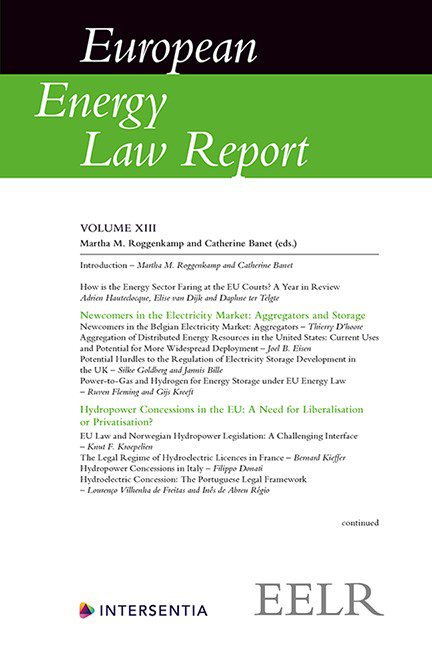Book contents
- Frontmatter
- Preface
- Contents
- List of Abbreviations
- List of Contributors
- Introduction
- Chapter I How is the Energy Sector Faring at the EU Courts? A Year in Review
- PART I NEWCOMERS IN THE ELECTRICITY MARKET: AGGREGATORS AND STORAGE
- PART II HYDROPOWER CONCESSIONS IN THE EU: A NEED FOR LIBERALISATION OR PRIVATISATION?
- PART III INVESTMENTS AND DISINVESTMENTS IN THE ENERGY SECTOR
- PART IV OFFSHORE DECOMMISSIONING IN THE NORTH SEA
- PART V CCS AS A CLIMATE TOOL: NORTH SEA PRACTICE
- PART VI FROM EU CLIMATE GOALS TO NATIONAL CLIMATE LAWS
Chapter VI - EU Law and Norwegian Hydropower Legislation: A Challenging Interface
Published online by Cambridge University Press: 30 April 2020
- Frontmatter
- Preface
- Contents
- List of Abbreviations
- List of Contributors
- Introduction
- Chapter I How is the Energy Sector Faring at the EU Courts? A Year in Review
- PART I NEWCOMERS IN THE ELECTRICITY MARKET: AGGREGATORS AND STORAGE
- PART II HYDROPOWER CONCESSIONS IN THE EU: A NEED FOR LIBERALISATION OR PRIVATISATION?
- PART III INVESTMENTS AND DISINVESTMENTS IN THE ENERGY SECTOR
- PART IV OFFSHORE DECOMMISSIONING IN THE NORTH SEA
- PART V CCS AS A CLIMATE TOOL: NORTH SEA PRACTICE
- PART VI FROM EU CLIMATE GOALS TO NATIONAL CLIMATE LAWS
Summary
INTRODUCTION
Norway is not a member of the European Union (EU), but fully integrated in the EU internal market through the rights and obligations included in the Agreement on the European Economic Area (EEA Agreement). The Agreement has general provisions on free movement of goods, services, workers and capital, on the right of establishment as well as competition, non-discrimination and state aid. The Agreement covers all sectors of the economy except agriculture and fisheries. The power sector, including hydropower, is included. In the annexes to the main text of the EEA Agreement, in particular in Annex IV, legislation relevant for the energy sector is included, multilaterally and dynamically following EU legislative initiatives. This is unlike the Swiss bilateral and static model for market integration based on ad hoc agreements. About 70 legal acts in the energy field have so far been included in the annexes to the EEA Agreement, including in particular the electricity market directive and the regulation on cross-border trade in electricity.
The EEA Agreement is based on a so-called ‘two-pillar’ structure whereby EU institutions and processes are ‘mirrored’ to ensure formal sovereignty for Iceland, Liechtenstein and Norway. This means that it is not the European Commission that controls implementation of the EEA Agreement, but the EFTA Surveillance Authority (ESA). The Court of Justice of the European Union (CJEU) does not hear cases regarding the EEA agreement, but instead the EFTA court.
Originally, it was assumed that the energy sector, and in particular the hydropower sector with its public ownership based on concessions and non- moveable assets, would not be much affected by the EEA Agreement.5 As this chapter will demonstrate, this has been proven wrong.
Initially, EU energy policy consisted largely in applying competition policy to the energy sector. This was also the starting point when the EEA Agreement was negotiated in the early 1990s. At that stage, there were nine EC regulations and directives on energy, which were incorporated into the EEA Agreement. The only mention of energy in the Agreement itself is in Article 24, in Part II on the free movement of goods.
- Type
- Chapter
- Information
- European Energy Law Report XIII , pp. 127 - 152Publisher: IntersentiaPrint publication year: 2020

